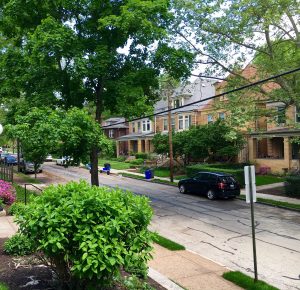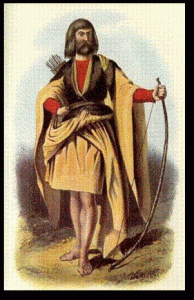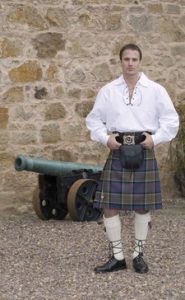
As I write this I’m sitting on my front porch looking at a tidy row of houses on precisely surveyed plots marked by hedges and fences. It’s a scene I take for granted and a marking of the land that seems normal to me. If I close my eyes and think beyond this porch and this street, I can see this grid of habitation and ownership extending, with variations and some interruptions, in all directions across this country like graph paper blanketing the land.
Four-hundred years ago this was not the case. North America, at that time, was settled as much of the world was, by various peoples who moved around as they needed to and did not answer to centralized authority. John Winthrop wrote, “The Indians … have [no] settled places, as Townes to dwell in, nor any ground as they challenge for their owne possession, but change their habitation from place to place.” And “They inclose noe Land.” Their non-ownership of individual pieces of land, more than anything else, marked the native population as “savage” in the eyes of the colonists.
Over two hundred years ago – when New England was already full of “settled places” and “townes” – tens of thousands of Scotch-Irish, including many of my ancestors, moved into western North Carolina, which was then the western frontier of white settlement. Land was cheap and the new nation needed white bodies to displace the natives, who were oddly inclined to do things like “challenge for their owne possession” people trying to take their land. My ancestors had originally been lowland Scots who lived near the border between Scotland and England and raided both sides with impunity. To pacify the border, James I moved many of them to Ulster in the 17th century, where they were to colonize the native population there on behalf of the English crown. Ireland was made up of multiple kingdoms or “tribes,” and like the Native Americans, the “wild Irish” were semi-nomadic. Many of them lived by “creaghting” – migrating seasonally with their cattle – and, as a result, they didn’t need permanent habitations. Cattle roamed rather than being fenced in, and the people roamed rather than being boxed in. Roaming, of course, was understood to be barbaric and wasteful, but it also made the population more difficult to control by a central authority. One of the first things the colonizers did in Northern Ireland was build stone houses and “bawns,” or stone walls, surrounding them, delineating their land and keeping the wild Irish out.
I wanted to understand these Scotch-Irish, my ancestors, who had colonized first the Irish and then the Cherokee. I dug deeper and found a description of lowland Scotland and its inhabitants, on the eve of the great migration to Ulster, from one of the standard sources, The Scotch-Irish: A Social History (1962), by James Leyburn, himself a North Carolinian. “Agricultural methods were of an unbelievable primitiveness. The people were utterly ignorant of any improvement elsewhere … since the Dark Ages.” Leyburn goes on to say disapprovingly, “There were no enclosures, no dykes or hedges between the fields, or even between farms….The cattle had to be … put into the care of a cow-herd or shepherd, who took them out every morning … and who chased them out of the unfenced fields of grain.” He adds, “The dirtiness of the hovels in which people lived was accepted … as one of the inevitabilities of life,” and, “some of the people had to be content to wear skins of animals for clothing.” So the lowland Scots, like the “wild Irish” and the Native Americans, had once been semi-nomadic “savages” who did not own or fence the land they lived on. They had their traditional life and land taken from them by the English. And then the colonized became the colonizers.
Who brought “civilization,” central government, and colonization to the English? The Romans, of course, who invaded what we now know as England but which was then a land controlled by multiple tribes. So I looked into the Romans and found Tacitus’s fascinating account, not of England, but “Germania,” as the Romans “discovered” it when they invaded. He writes, “It is well known that none of the German nations inhabit cities; or even admit of contiguous settlements. They dwell scattered and separate, as a spring, a meadow, or a grove may chance to invite them. Their villages are laid out, not like ours in rows of adjoining buildings; but every one surrounds his house with a vacant space, either by way of security against fire, or through ignorance of the art of building. For, indeed, they are unacquainted with the use of mortar and tiles; and for every purpose employ rude unshapen timber, fashioned with no regard to pleasing the eye.”
He goes on to say, “Nor do they attempt to make the most of the fertility and plenty of the soil … in planting orchards, inclosing meadows, and watering gardens.” And they “live in a state of amazing savageness and squalid poverty…. Their food is herbs; their clothing skins.” Once again we see a native population, living in a system of decentralized power and communal land use, characterized as ignorant and barbaric and in need of correction and control by those who are “civilized” (and who want land, resources, and the power civilization grants). So the English, like the Scots, were a colonized people who became a colonizing people. How does that happen? How do a people forget what was taken from them by force and then use force to take those same things from others? Is it a kind of Stockholm syndrome where we identify with our captors. Or perhaps it’s simply people doing what they must to survive.
Coming back to the present, to my front porch, and feel the touch of Caesar’s hand. Because in it I see Tacitus’s Roman village, “laid out … in rows of adjoining buildings” and “inclosed meadows.” I see that my street, my world, is the result of the centralization of authority on the land, an authority that needs to commodify, count, and control the land and its people. And like my Scotch-Irish ancestors, we in America are both colonized and colonizers



